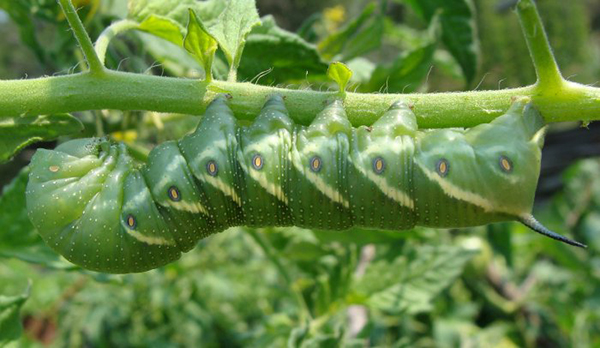by Linda Carloni
Harvesting and planting may be more glamorous, but pest management is just as crucial to your garden, be it summer or fall. Ideas for managing some issues your garden may be experiencing now:
Tomatoes – hornworms
One of the most frustrating tomato pests is the hornworm. The hornworm moths lay single eggs on the tomato leaves. When the caterpillars hatch, they munch on your tomato leaves and fruit. The caterpillars get very large, but their color and stripy pattern makes them hard to see. Large, squarish, black or dark green droppings signal the likelihood of hornworm caterpillars. They can be managed by finding them, picking them off and cutting them in two. More on hornworm: http://ipm.ucanr.edu/PMG/GARDEN/VEGES/PESTS/hornworm.html
Squash and cucumbers – powdery mildew
Powdery mildew is incredibly common in Alameda – it thrives in our moderate temperatures (60 to 80 degrees F) and the shady conditions so prevalent in our small back yards. Powdery mildew does not require moisture so it can survive well in our dry summers. In Alameda, zucchini, other summer squash, cucumbers and peas are commonly affected, and sometimes other plants. Prevention is the most effective way to manage it – planting resistant varieties, avoiding planting susceptible plants in shady spaces, giving plants plenty of room to encourage air circulation and not over-fertilizing. Check often for the telltale powdery white spots on both sides of the leaves. Once powdery mildew starts, it’s hard to manage. You can slow down an early infestation by clipping off or washing off the leaves. Some gardeners successfully use homemade sprays with baking soda or whey diluted in water with a tiny bit of dish soap – you can find instructions on the Internet if you want to try them. Spraying horticultural oils or fungicides can also help.
More on powdery mildew: http://ipm.ucanr.edu/QT/powderymildewcard.html
Broccoli, cabbage and the like – cabbage looper caterpillars
Many of the starts planted in late summer/early fall are susceptible to these voracious caterpillars, which can devastate tender seedlings fast. These “cole crop” seedlings need protection with floating row covers, Bt spray or other techniques.
More on cabbage looper caterpillars: https://alamedabackyardgrowers.org/cool-season-time-to-start-planting/ and
http://ipm.ucanr.edu/PMG/GARDEN/VEGES/PESTS/loopers.html
Tender greens and so much else – Snails and slugs
Snails and slugs are among the most destructive garden pests. While they especially like young seedlings and other tender leaves, they also attack citrus frequently and as well as many other vegetables and other plants. There are many methods for managing snails and slugs. Handpicking at night using a flashlight is the most straightforward, and using small tins sunk to soil level with an inch or so of beer is a traditional favorite. Building traps, using barriers they don’t like to cross and using safer snail baits are also valuable techniques.
More on snails and slugs: http://ipm.ucanr.edu/QT/snailsslugscard.html
Aphids and their friends the ants
Many vegetable plants are susceptible to aphids. Some aphids don’t tolerate heat and are mostly a problem in the spring. But others stick around, frequently aided by ants. Ants value the sweet sticky residue of the aphids, and protect them from their natural enemies so they can thrive. Keeping ants away from the plant while you are managing the aphids is critical. To manage the aphids, first try to knock the aphids off by spraying the plant with a strong stream of water. Repeat this every few days. If this isn’t sufficient, you can prune infested leaves and stems. And as a last resort, you can spray with horticultural oils. Seedlings may need to be protected with covers or aluminum foil mulches.
More on aphids: http://ipm.ucanr.edu/QT/aphidscard.html
And remember the flowers
Gardens have an ecosystem, and do best when they contain a diversity of plants that attract a variety of insects. Some of the bugs you attract can make your pest management easier because those “beneficial insects” attack the insects that are diminishing your yields. I don’t have that much sun in my yard, so I’ve usually reserved the limited sunny space for the vegetables, and haven’t grown flowers in the immediate area. This year, I (like many) had more time to work on my garden in the spring, and I scattered around pots of flowers known to attract pollinators and beneficial insects. The increase in beneficial insects and in pollination was dramatic.
So in the spring, remember to plant some plants known to attract the insects you want, and see if they make a difference for you.

